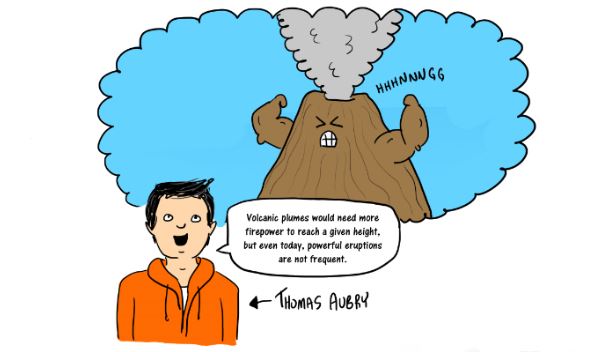16 November 2016
Global warming could reduce volcanic cooling effects on climate
Posted by larryohanlon
By Larry O’Hanlon
Earth’s warming climate could put a damper on explosive volcanic eruptions that spew climate-cooling compounds into the stratosphere, according to a new study.
It has long been known that powerful volcanic eruptions pour sulfur dioxide and other particles into the stratosphere, the second layer of the atmosphere above the weather and clouds. Particles reaching the stratosphere can hang around for one or two years, reflecting sunlight back into space and cooling the climate.
What’s less well known is that human-caused warming of the atmosphere could make it harder for explosive volcanic plumes to reach the stratosphere. New research finds that as the climate warms, Earth’s atmosphere could trap more volcanic plumes in the troposphere, the lower part of the atmosphere where weather happens. Volcanic aerosols that stay in the troposphere get washed out by precipitation in days or weeks.
This means volcanic eruptions would have less of a cooling effect on the Earth’s climate, according to Thomas Aubry, a PhD student at the University of British Columbia in Vancouver and lead author of the new study in the Journal of Geophysical Research: Atmospheres, a publication of the American Geophysical Union.

Click on the illustration to see the entire cartoon version of this article at The Plainspoken Scientist blog. Illustration by JoAnna Wendel @JoAnnaScience.
“You would need more powerful eruptions to reach the stratosphere,” said Aubry. “And since they are less common, there would be less volcanic effect on climate.”
As a result, average sulfur dioxide concentrations in the stratosphere could drop by 2 percent to 12 percent by 2100, and from 5 percent to 25 percent by the year 2300, according to the new research.
The loss of the climate cooling sulfur dioxide in the stratosphere would have only a small impact on the overall climate, Aubry pointed out. But it’s still quite measurable. For instance, other researchers have found that similar changes in sulfur dioxide reaching the stratosphere helped to slow the rate of global warming at the beginning of the 21st century. Sorting out this effect is important for understanding how volcanoes affect the stratosphere over time, and to fine-tune climate models, he said.
Modeling eruptions
Aubry and his colleagues from Canada, the UK and Switzerland used global climate models to study the effects of climate change on volcanic eruptions for three centuries into the future.
“What we do in this study is take realistic volcanic eruptions and use a model to assess whether their plume would reach the stratosphere under different greenhouse gas scenarios for the climate,” said Aubry.
One climate scenario assumes carbon dioxide concentrations will level out at fewer than 600 parts per million by 2100. Another scenario puts carbon dioxide concentrations at an extreme 1,200 parts per million by the end of the century. For comparison, the average carbon dioxide concentration measured at Mauna Loa, Hawaii, passed the 400 parts per million mark at the end of 2015, according to the National Oceanic and Atmospheric Administration (NOAA).
The study’s authors then modeled volcanic eruptions under these different scenarios.
Volcanic plumes are bursts of hot ash and gas. Air enters the plume and mixes with the volcanic gases, causing the plume to rise high into the atmosphere like a hot air balloon.
As Earth’s troposphere warms, climate models predict that it will become more layered – or stratified. This increase in stratification has already been observed in the tropics. Under these conditions, volcanic plumes would then stabilize at lower altitudes and spread, the same way a thunderhead stops rising and flattens out. The warming of the troposphere will also thicken this layer of the atmosphere, so the lower boundary of the stratosphere will be higher. Both effects make it harder for rising plumes of volcanic gases to penetrate into the stratosphere, Aubry said.
The new study shows that under both climate scenarios, some tropical volcanic plumes that reached the stratosphere in the past 15 years would be trapped in the troposphere if similar eruptions were to happen in 2100.
— Larry O’Hanlon is a freelance science writer, editor and social media manager. He manages the AGU blogosphere.


 GeoSpace is a blog on Earth and space science, managed by AGU’s Public Information staff. The blog features posts by AGU writers and guest contributors on all sorts of relevant science topics, but with a focus on new research and geo and space sciences-related stories that are currently in the news.
GeoSpace is a blog on Earth and space science, managed by AGU’s Public Information staff. The blog features posts by AGU writers and guest contributors on all sorts of relevant science topics, but with a focus on new research and geo and space sciences-related stories that are currently in the news.